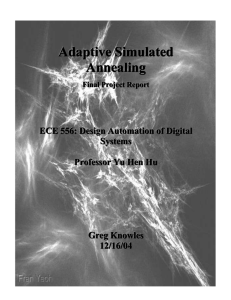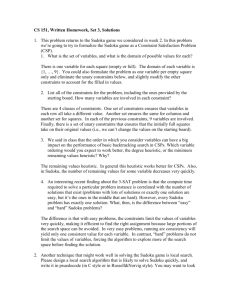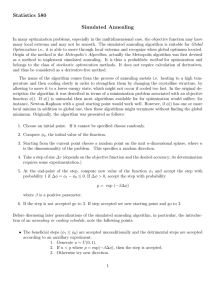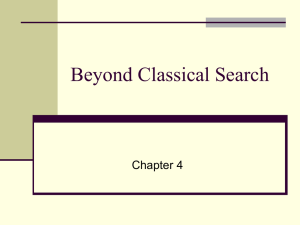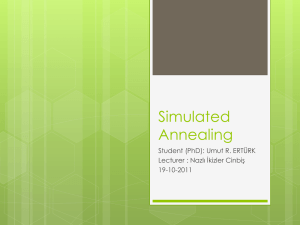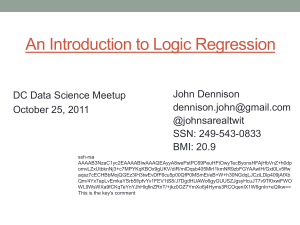SIMULATED ANNEALING DETERMINATION OF SHEAR WAVE TRAVEL TIME
advertisement
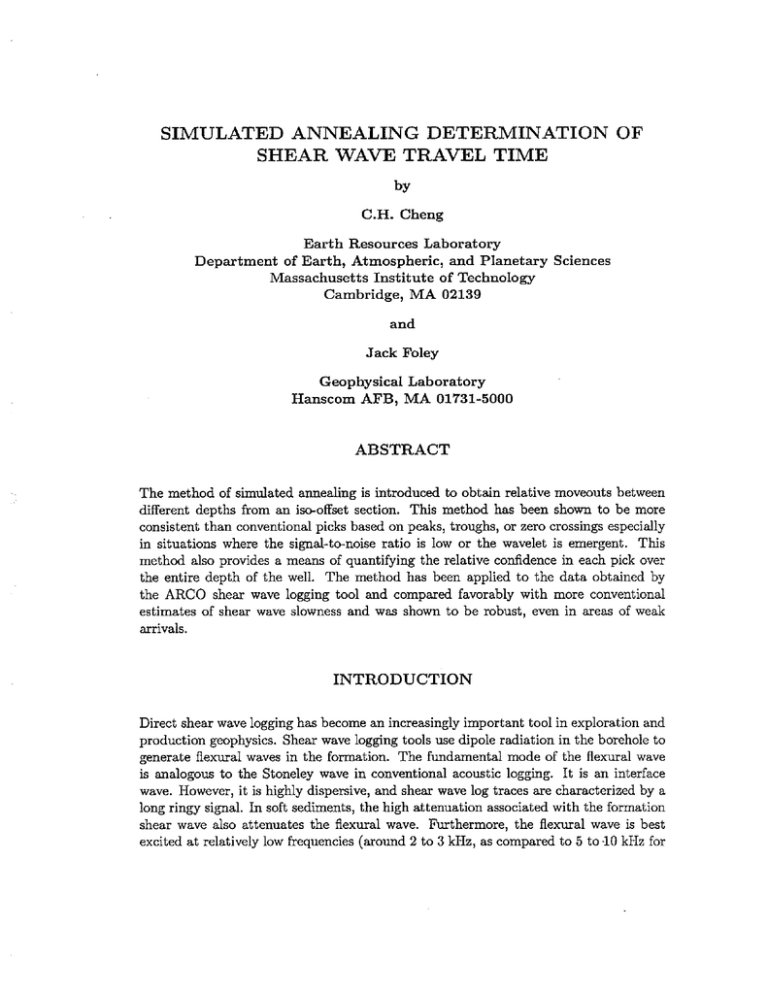
SIMULATED ANNEALING DETERMINATION OF
SHEAR WAVE TRAVEL TIME
by
C.H. Cheng
Earth Resources Laboratory
Department of Earth, Atmospheric, and Planetary Sciences
Massachusetts Institute of Technology
Cambridge, MA 02139
and
Jack Foley
Geophysical Laboratory
Hanscom AFB, MA 01731-5000
ABSTRACT
The method of simulated annealing is introduced to obtain relative moveouts between
different depths from an iso-offset section. This method has been shown to be more
consistent than conventional picks based on peaks, troughs, or zero crossings especially
in situations where the signal-to-noise ratio is low or the wavelet is emergent. This
method also provides a means of quantifying the relative confidence in each pick over
the entire depth of the well. The method has been applied to the data obtained by
the AReO shear wave logging tool and compared favorably with more conventional
estimates of shear wave slowness and was shown to be robust, even in areas of weak
arrivals.
INTRODUCTION
Direct shear wave logging has become an increasingly important tool in exploration and
production geophysics. Shear wave logging tools use dipole radiation in the borehole to
generate flexural waves in the formation. The fundamental mode of the flexural wave
is analogous to the Stoneley wave in conventional acoustic logging. It is an interface
wave. However, it is highly dispersive, and shear wave log traces are characterized by a
long ringy signal. In soft sediments, the high attenuation associated with the formation
shear wave also attenuates the flexural wave. Furthermore, the flexural wave is best
excited at relatively low frequencies (around 2 to 3 kHz, as compared to 5 to 10 kHz for
226
Cheng and Foley
conventional full waveform logs, Schmitt, 1988). This combination of low frequency and
high attenuation results in flexural wave arrivals that are often emergent, making the
exact travel time selection difficult to accurately measure manually or with interactive
computer graphics software. Furthermore, a number of existing or prototype shear wave
tools have only two or at most four receivers, making array processing difficult (Willis,
1983).
In essence, we are back to the original problem of shear wave velocity determination
from full waveform logs that we encountered a decade ago, except that this time around
the problem is more severe because of the lower frequency content and higher attenuation. In conventional monopole full waveform logging, the shear wave only exists in the
"hard" formation where the shear wave velocity is higher than the acoustic velocity of
the borehole fluid. Under such circumstances, the shear wave attenuation tends to be
low, and the frequencies of the shear/pseudo-Rayleigh wave packet are usually around
10 kHz at cutoff. Even under these better conditions, Willis (1983) pointed out that the
picking of individual arrival times on different traces is prone to error and the results
are usually inconsistent from depth to depth.
In this paper we look at a new statistical approach when dealing with the problem
of obtaining a shear wave velocity from the shear wave log. The key difference from
conventional velocity picking and using the resultant moveout is that instead of using
receivers from the same depth we will be using the same source-receiver (iso-offset) combination over a large number of depths. This is done by recasting the phase identification
problem as an optimization problem. We design a function which will be maximized
when each of the traces on the depth array is time shifted by amounts related to the
differential travel time of the flexural wave arrival. In this way, we obtain a relative
travel time of the flexural wave arrival over the whole depth. The process is repeated
for a second source-receiver pair. The flexural wave moveout between the two receivers
can then be determined by cross-correlating the first traces on the two source-receiver
pairs. This way, we are guaranteeing consistent picks over the whole depth.
In the next section, we detail the simulated annealing based optimization method
for measuring arrival times of shear wave logging data. The real-data application of
this technique is presented in the final section. The simulated annealing technique is
applied to data from ARCO's shear wave logging tool and the results are compared with
automatic arrival time picking based on zero crossings provided by ARCO and also with
shear wave velocity determined from cross correlation of the data from the two receivers
at individual depths.
Simulated Annealing
227
SIMULATED ANNEALING METHOD
The application of simulated annealing optimization to the problem of shear wave velocity determination helps to overcome some of the problems which make the travel
time picks oflow frequency emergent arrivals difficult and unreliable. In particular, the
simulated annealing method helps us to quantify the accuracy of the picks by defining
a probability associated with each travel time selection. As shown in Foley (1990), this
method works well when the signal-to-noise ratio is low and when we ordinarily have
difficulty pinpointing emergent arrivals in noisy data. Methods which utilize a probabilistic approach to solve various types of seismic travel time problems have had limited
but successful application in the past. Rothman (1986) used the simulated annealing
method to solve the problem of station statics corrections in reflection data. Landa et
al. (1989) used a generalized simulated annealing technique (Bohachersky et aI., 1986)
for trace coherency optimization and CMP velocity estimations. Zeit et al. (1987) used
a semblance optimization technique to select low amplitude refracted arrivals.
In the shear wave travel time applications, we search for a set of trace shifts that
maximizes (optimizes) the total energy content of a group of seismograms windowed
to contain the shear/flexural wave arrival. This group of seismograms is made up of
records from a single source-receiver offset for a certain depth range.
N-window N-traces
£=
I: ( I:
i=l
di,j("Tj))2,
(1)
j=l
where £ is defined as the power of the stacked trace, called the stack power, which we
want to optimize, di,j ("Tj) is the i'h point in the j'h seismogram and "T is the shift of the
j'h seismogram determined with this procedure. We use this optimization technique
to determine the lags "T(i) in the data which maximize the stack power of the targeted
arrival. Only windowed portions of the full waveforms are used in this process, and
these windows are defined for each depth by assuming that the arrivals fall within a
predetermined range of travel times. These windows only define the portion of the
seismogram in the time in which the targeted arrival is expected and do not shape
or transform the data. We will refer to the stack of these windows as the annealing
stack. We use simulated annealing optimization to efficiently maneuver through this
multi-dimensional data space in an iterative process to locate the configuration with
the maximum annealing stack power.
Simulated annealing is a Monte Carlo optimization procedure which is designed to
globally optimize an objective function that contains local minima (Rothman, 1986).
The term Monte Carlo means that at some point in the process a randomly generated
number is used, and as we shall see below, this process is a Monte Carlo method because
we generate a random number to make selections from probability distributions. The
idea of simulated annealing, introduced by Kirkpatrick et al. (1983), is that one can
228
Cheng and Foley
make an analogy between optimization of a function and the physical process of crystal
growth (annealing). In this travel time problem, we wish to align all seismograms
recorded from an iso-offset section such that the power of the annealing stack is greatest;
this is our objective function. In early iterations we allow traces to be shifted with few
constraints. These early iterations are analogous to the high temperature state of crystal
growth, where a crystal is still mainly liquid and can attain virtually any molecular
configuration. Later, the temperature of the process is lowered and the range of possible
trace shifts becomes limited. Similarly, before a melt solidifies, the motion of individual
molecules is not widely constrained, but as the temperature is lowered (slowly) to the
Curie point, the range of motion is reduced until the final crystal lattice is developed.
This optimization can also be thought of as the determination of a set of parameter values (trace shifts) which minimizes a function (1/stack power) which contains
local minima. This function has an energy state at each possible combination of trace
lags, and simulated annealing finds the lowest energy level. Attempting to locate this
global minimum with conventional iterative improvement techniques can lead to solutions which rest in local minima (Tarantola, 1987). We use simulated annealing to insure
that the global minimum is reached in each case by iteratively optimizing the function
and probabilistically allowing steps which temporarily have higher energy levels than
previous iterations; we carefully allow for uphill motions on the objective function to
avoid local minima. An outline of the simulated annealing procedure described below is
shown schematically in Figure 1 and follows the procedure outlined by Rothman (1986).
1. The procedure begins by determining the time window for each trace for the
targeted arrival. This could be a window around the shear wave arrival picked
manually, or based on a multiple of the P-wave arrival time.
2. All trace shifts are initially set to zero.
3. The windowed data are summed to produce the annealing stack and the stack
power is calculated.
4. One seismogram is removed from the annealing stack and a cross correlation is
made between that trace and the sum of the remaining traces, which we refer to
as the partial stack. This correlation is referred to as the trace correlation below.
5. The trace correlation function is converted into a probability distribution using
a temperature conversion factor. The time shifts are weighted by the probability
function and a selection is made from this weighted distribution. This time pick
is the trace lag for the current iteration.
6. The trace lag is applied to the data and the shifted trace is added back into the
partial stack.
Simulated Annealing
229
7. We return to step 4 until each seismogram in the iso-offset section is processed for
the current iteration.
8. The temperature parameter is lowered to limit the probability of shifting traces
by lags with low trace correlation levels.
9. We return to step 3 for N iterations.
There are a few key points in this procedure:
• At each step in the procedure the data are aligned and summed to produce an
annealing stack. This function is a very poor representation of the source wavelet
in early iterations, and for the first iteration it is simply a summation of all the
prediction windows.
• By the end of the optimization procedure the annealing stack develops into an
excellent representation of the source wavelet.
• The trace correlation function is converted into a probability distribution using
the relation,
PDF(i) = exp(XGOR(i)/T).
(2)
Here PDF(i) is the probability distribution, XGOR(i) is the trace correlation
function and T is the conversion temperature. The temperature parameter controls
the conversion from trace correlation to probability distribution. High temperatures (early iterations) produce probability distributions which are more uniform,
where low correlation values have relatively high probabilities, and low temperatures (late iterations) produce distributions with fewer and greater spikes; see
Figure 2.
• A random selection is made from the PDF to determine the shift to be applied
to the trace before it is added back into the partial stack. The random nature of
this selection makes this a Monte Garlo method.
• With this procedure we probabilistically allow for shifts not associated with the
maximum trace correlation when defining the optimal trace alignment. This allows
us to avoid local minima.
• The procedure is executed for each station in the annealing stack to complete
a single iteration. Many iterations are often reqnired with simulated annealing
(Rothman, 1986), but in this work stable trace configurations are generally found
in as few as 25 iterations. Implications of these values are discussed below.
230
Cheng and Foley
IMPLEMENTATION ISSUES
Conversion to Absolute Travel Times
The simulated annealing method is applied separately to each source-receiver separation.
After a suite of trace shifts which maximize the st·ack power are determined, we calculate
the relative delay for each station included in the event. The procedure is followed for
all receivers. To obtain a shear wave velocity, we need to know the moveout between
the receivers at the first depth, since the arrival times are picked relative to the first
depth. In our example using ARGO's shear wave tool, there are two receiver positions.
In order to compare the results with the automatic picks provided by ARGO, we shifted
our relative picks such that the mean difference between the simulated annealing picks
and ARGO's picks is minimized.
Conversion Temperature
The conversion from cross correlation to probability distribution is very important in
the simulated annealing method (Rothman, 1986). In general there are three different conversion schemes: no annealing (T = 0; conventional cross-correlations), steady
state annealing (T = constant for all iterations) and temperature varying annealing
(T = To . [1 - cooling rate] iteration) . The temperature is a sensitive parameter, and
a 10% change in starting temperature can cause the proced;'re to get trapped in local
minima. By implementing a scheme where temperature varies with iteration, a wider
range of starting temperatures can be used. We significantly reduce the importance of
the starting temperature and therefore automate the process. The tradeoff of this implementation is that the number of iterations necessary for the procedure to converge is
increased. We find that in most cases we see convergence within 30-150 iterations. This
convergence is quite rapid in contrast to the 3500 iterations Rothman (1986) needed to
anneal data for static corrections. The relatively small number of iterations required in
this application indicates that global minima can be easily reached with the application
of this probabilistic approach to travel time picking and that the problem is not strongly
contaminated with local minima.
RESULTS
The results of applying simulated annealing to the shear wave logging data are compared with those from two different picks: direct picks from ARGO and a simple crosscorrelation between the two receivers with no interpretation of the cross-correlation
function.
Simulated Annealing
231
Before we go on to discuss the simulated annealing results, it is instructive to examine
the shear wave velocity obtained from the more conventional methods and thus have
a feel for the accuracies involved. Figure 3 plots the shear wave slowness obtained by
direct picks and those from cross-correlation. The two different methods of determining
shear wave velocity show a small offset of 1.6 Jl-s/ft but a relatively large standard
deviation of 7.6 Jl-s/ft. Since the shear wave tool has a digitization interval of 11 Jl-S and
an inter-receiver spacing of 4.5 ft, a mispick of 1 point represents an error of 2.44 Jl-s/ft.
Figures 4 and 5 show the comparisons between the picks provided by ARCO and
those obtained by simulated annealing. The simulated annealing was done using 650
traces representing 325 ft. The two receivers were separately iterated. Since simulated
annealing provides only a relative moveout between depths in this case, these relative
times were converted to absolute times by matching them with the ARCO picks such
that the mean difference between them is minimized. Also plotted by the side is the
cross correlation peak for each depth.
In general, there is excellent agreement between the simulated annealing picks and
those done by more conventional means from ARCO. For the near receiver, the mean
difference between the two picks is 4 Jl-sec, less than half a digitization point. The
standard deviation is 22 Jl-sec, or two digitization points. For the far receiver, the mean
difference between the two picks is even smaller at 1 Jl-sec, but the standard deviation
is larger at 36 Jl-sec, a little over 3 digitization points.
Figure 6 shows the comparison of the shear wave slowness as a function of depth
obtained by simulated annealing and conventional picks. There is good agreement
between the two, with a mean difference of 1.1 Jl-s/ft (or half a digitization point) and
a standard deviaton of 8.6 Jl-s/ft (or three and a half points). Figure 7 shows the
comparison of the shear wave slowness as a function of depth obtained by simulated
annealing and cross correlation between two receivers. There is even better agreement
between the two, with a mean difference of 0.3 Jl-s/ft and a standard deviation of 5.8'
Jl-s/ft (or two and a half points).
One of the reasons why the standard deviation for the far receiver is larger is the
significant disagreement between the simulated annealing picks and the ARCO picks at
depths 3710 to 3720 ft. At the same time, the cross correlation peak shows much poorer
correlation in the simulated annealing picks. This results in the only place where there
is significant disagreement between the simulated annealing shear wave slowness and
that from conventional picks. In order to resolve this difference, we have plotted the
actual waveforms at 3714.5 ft together with the picks (Figure 8). For the near receiver,
the two picks lie right on top of each other (actually they are one digitization point
apart, but are too close to resolve at this plotting scale). For the far receiver, it is
clear that there is a distortion of the waveform shape of the first arrival, resulting in
a double trough right after the first peak. Simulated annealing picks the first trough,
while ARCO picks the second trough.
232
Cheng and Foley
Another way of visualizing what is happening is to examine the iso-offset plots
(Figures 9 and 10). Figure 9 is the iso-offset plot of the near receiver seismograms.
As can be seen from the figure, the waveforms are consistent and the first arrivals are
easy to identify. However, in the iso-offset plot for the far receiver (Figure 10), one
can see where the differences between the simulated annealing and the conventional
picking algorithm arise. The leading arrivals from 3705 to 3715 ft are emergent, making
proper identification of the arrival time difficult. Since simulated annealing uses the
cross-correlation between different traces within the arrival window (in this case with a
window length of about 100 points or 1100 fJ-sec), it does a much better job in these cases
where the exact pick can be ambiguous. Significantly, simple cross correlation between
the two receivers results in a shear wave slowness more in line with the simulated
annealing results (see Figure 7).
CONCLUSIONS
We have introduced the method of simulated annealing to obtain relative moveouts
between different depths from an iso-offset section. This method has been shown to
be more consistent than conventional picks based on peaks, troughs, or zero-crossings.
Because it performs cross correlation over a wide depth range, it is possible to obtain
consistency over the entire well, instead of just over the receiver array. It is also possible
to compare the relative reliability of the picks over depth. We have applied this method
to a section of shear wave logs and the results are more consistent than conventional
picking and cross correlation methods over a section where the first arrivals are emergent.
ACKNOWLEDGEMENTS
We would like to thank Ken Tubman and ARCO Oil and Gas Co. for providing the
shear wave logging data and the actual shear wave picks. This work was supported by
the Full Waveform Acoustic Logging Consortium at M.LT.
Simulated Annealing
233
REFERENCES
Bohachecsky, 1., M. Johnson, and M. Stein, Generalized simulated annealing for function
optimization, Technometrics, 28, 209-217.
Foley, J.E., 1990, Crustal Structure from Teleseismic Bodywave Data, Sc.D. Thesis,
M.LT., Cambridge, MA.
Kirkpatrick, S., C. Gelatt, and M. Vecchi, 1983, Optimization by simulated annealing,
Science, 220, 671-680.
Landa, E., W.B. Beydoun, and A. Tarantola, 1989, Reference velocity model estimation from prestacked waveforms: coherency optimization by simulated annealing,
submitted to Geophysics.
Rothman, D.H., 1986, Automatic estimation of large residual statics corrections, Geophysics, 51, 332-346.
Schmitt, D.P., 1988, Shear wave logging in elastic formations, J. Acoust. Soc. Am.,
2215-2229.
84,
Tarantola, A., 1987, Inverse Problem Theory, Elsevier, New York.
Willis, M.E., 1983, Seismic Velocity and Attenuation From Full Waveform Acoustic
Logs, ph.D. Thesis, M.LT., Cambridge, MA.
Zeit, C.A., J.J. Drew, M.J. Yedlin, and A.M. Ellis, 1987, Picking noisy refraction data
using semblance supplemented by a Monte Carlo procedure and spectral balancing,
Bull. Seis. Soc. Am., 77, 942-957.
234
Cheng and Foley
Data
Stack
X-Cor
PDF
Figure 1: Simulated annealing optimization procedure schematic: A seismogram is windowed to contain the proper phase (top). All other depths are added to create
the partial stack (second). A cross correlation is calculated between the windowed
seismogram and the partial stack (third) and then converted into a probability distribution (fourth) using the temperature conversion scheme. A random selection is
made from the distribution to define the trace shift. The data is shifted and the
stack is updated.' This procedure is done for each trace defining one iteration.
Simulated Annealing
235
Cross
Correlation
PDF; T=O.5
PDF; T=O.l
PDF; T=O.05
PDF; T=O.Ol
Trace Shifts
Figure 2: The conversion of cross correlation to probability distribution is dependent
on the temperature (see text). Top figure shows a typical cross correlation between
a prediction window and a partial stack. Below are the probability distributions for
temperatures of 0.5, 0.1, 0.05, and 0.01. As the temperature is lowered, we limit the
probability associated with low correlation lags.
Cheng and Foley
236
- - S slowness (dipole)
•
S slowness (correlation)
3600
3650
3700
3750
,.
3950
4000
160
180
200
220
Slowness (J-lslft)
240
260
Figure 3: Comparison between shear wave slowness obtained by a conventional picking
algorithm used by ARCO and a straightforward cross correlation method which
measures the moveout between the two shear wave receivers.
237
Simulated Annealing
--Near Receiver Picks (microsec)
Cross Correlation peak
Simulated Annealing picks
3600
3600
3650
3650
3700
3700
3750
3750
g
g
-5
3800
0-
-'=
Cl
Cl
a
"
3800
"
3850
3850
3900
3900
3950
3950
4000
4000
1600 1700 1800 1900 2000 2100 2200
0.5
0.62
0.75
0.88
Figure 4: Comparison of arrival time picks for the near receiver from simulated annealing
and those done by ARCO using a conventional picking algorithm. Also plotted is
the peak cross correlation value for the trace from simulated annealing.
238
Cheng and Foley
--Far Receiver Picks (microsec)
•
Simulated Annealing picks
Cross Correlation peak
3600
3600 ,--r----,,-----,----,
3650
3650
3700
;il"
,
3700
3750
3750
g
a
g
3800
% 3800
'""
3850
3850
3900
3900
3950
3950
"
'"
4000
4000
2600 2700 2800 2900 3000 3100 3200
0.5
0.62
0.75
0.88
Figure 5: Comparison of arrival time picks for the far receiver from simulated annealing
and those done by ARCO using a conventional picking algorithm. Also plotted is
the peak cross correlation value for the trace from simulated annealing.
Simulated Annealing
239
- - $ wave slowness (dipole)
•
S slowness (simulated annealing)
3600
3650
..
3700
-j
~. .,
r•
•
3750
••••••
g
.c
a
3800
• • LI·
"
Cl
•
3850
•
3900
3950
4000
160
180
200
220
240
260
Slowness (l'Sift)
Figure 6: Comparison between shear wave slowness obtained by a conventional picking
algorithm used by ARCO and the results from simulated annealing.
Cheng and Foley
240
- - 8 slowness (correlation)
•
S slowness (simulated annealing)
3600
II
3650
a
3700
3750
%
Cl
'"
3800
3850
a
a
'r
3900
:
3950
.
{,
•
ilia
:I •
,..
\
4000
160
180
200
220
240
260
Slowness (J.lSIft)
Figure 7: Comparison between shear wave slowness obtained by a conventional cross
correlation between the near and far receivers and the results from simulated annealing.
Simulated Annealing
Both
/
Simulated /
Annealing
o
241
2000
\ARGO
4000
6000
8000
10000
12000
TIME (JlSec)
Figure 8: Seismograms for the near and far receivers obtained by the shear wave logging
tool at 3714.5 ft. Plotted on top of the seismograms are the arrival picks from ARea
and from the simulated annealing algorithm.
242
Cheng and Foley
NEAR RECEIVER
3710
3720
o
2000
4000
6000
8000
10000
12000
TIME (IlSEC)
Figure 9: Iso-offset shear wave log seismograms for the near receiver for the depths 3700
to 3724 at one foot intervals.
Simulated Annealing
243
FAR RECEIVER
3715
3725
o
2000
4000
6000
8000
10000
12000
TIME (IlSEC)
Figure 10: Iso-offset shear wave log seismograms for the far receiver for the depths 3705
to 3729 at one foot intervals.
244
Cheng and Foley

